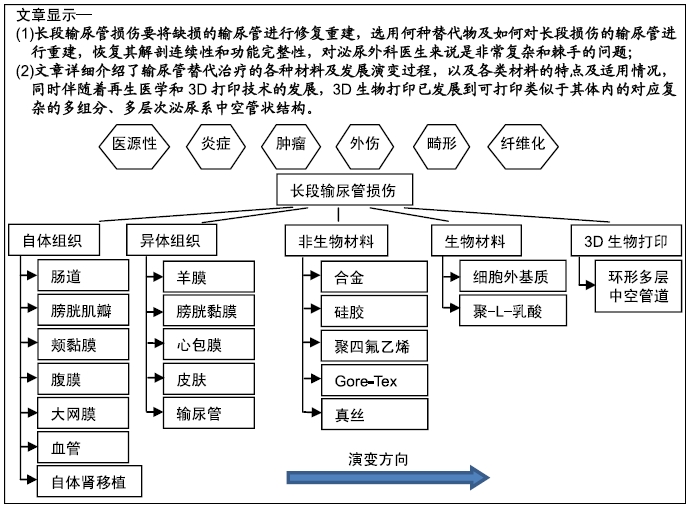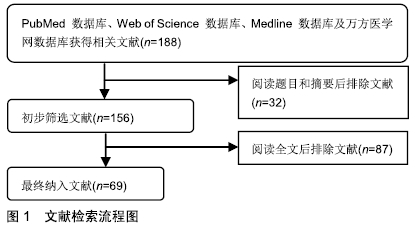[1] ARMATYS SA, MELLON MJ, BECK SD, et al.Use of ileum as ueteral replacement in urological reconstruction.J Urol. 2009; 181(1):177-181.
[2] ELLIOTT SP, MCANINCH JW.Ureteral injuries: external and iatrogenic.Urol Clin North Am.2006;33(1):55-66.
[3] MOAWAD G, ASTRID VON WALTER G.Management of urinary tract injuries in minimally invasive gynecologic surgery.Topics Obstet Gynecol.2013;33(3):1-7.
[4] 周磊长段输尿管损伤后两种不同替代组织选择的解剖学研究[D].石家庄:河北医科大学,2015.
[5] 熊云鹤,杨嗣星.长段输尿管缺损修复技术的演进与技术革新[J].中华腔镜泌尿外科杂志(电子版),2017,11(4):215-218.
[6] DAHMS SE, PIECHOTA HJ, NUNES L, et al.Free ureteral replacement in rats:regeneration of ureteral wall components in the acellular matrix graft.Urology.1997;50:818-825.
[7] LEWIS HY, SHERWOOD NS, PIERCE JM, et al.Experimental and clinical use of urethal prosthesis.J Urol.1996;95:700-705.
[8] MATTOS RM, SMITH JJ 3RD.Ileal ureter.Urol Clin North Am. 1997;24(4):813-825.
[9] GOODWIN WE, WINTER CC, TURNER RD.Replacement of the ureter by small intestine:clinical application and results of the ileal ureter.J Urol.1959;81(3):406-418.
[10] SIM A, TODENHOFOR T, MISCHINGER J, et al.Totally intracorporeal replacement of the ureter using whole-mount ileum. J Endourol.2014;28(10):1165-1167.
[11] POPE J, KOCH MO.Ureteral replacement with reconfigured colon substitute. J Urol.1996;155:1693.
[12] ALI-EL-DEIN B, GHONEIM MA.Bridging long ureteral defects using the Yang-Monti principle. J Urol.2003;169:1074.
[13] KATO H, IGAWA Y, NISHIZAWA O.Transverse colon pouch with total replacement of the ureter by reconfigured coIon segment.J Urol.1999;161:1902-1903.
[14] UBRIG B, WAIDNER M, ROTH S.Reconstruction of ureter with transverse retubularized colon segments.J Urol. 2001;166: 973-976.
[15] YANG WH.Yang needIe tunneling technique in creating anti-reflux and continent mechanisms.J Urol.1993;150:830-834.
[16] MONTI PR, LARA RC, DUTRA MA, et al.New techniques for construction of efferent conduits based on the Mitrofanoff principle. Urology.1997;49(1):112-115.
[17] CASTELLAN M, GOSALBEZ R.Ureteral replacement using the Yang-Monti principle:long-term follow-up.Urology. 2006;67(3): 476-479.
[18] 陈嵘,徐月敏,乔勇,等.抗反流技术的回肠代输尿管治疗腹膜后纤维化引起肾积水的疗效观察[J].同济大学学报(医学版), 2009,30(6): 66-68.
[19] 刘沛,吴鑫,朱雨泽,等.回肠代输尿管术治疗医源性长段输尿管损伤[J].北京大学学报(医学版),2015,47(4):643-647.
[20] DENG S, DONG Q, WANG J, et al.The role of mechanical bowel preparation before ileal urinary diversion:a systematic review and meta-analysis.Urol Int.2014;92(3):339-348.
[21] 王文忠,臧美孚,郑绍富,等.阑尾修复左侧输尿管[J].中华外科杂志, 1997,35(12):733-734.
[22] SUTHERLAND RS, PFISTER RR, KOYLE MA.Endopyelotomy associated ureteral necrosis:complete ureteral placement using the Boari flap.J Urol.1992;148(5):1490-1492.
[23] 李永伟,杨嗣星,吴天鹏,等.螺旋状带蒂膀胱肌瓣输尿管成形术修复全程输尿管损伤的疗效分析(附6例报告)[J].临床泌尿外科杂志, 2014,29(4):296-299,303.
[24] SOMERVILLE JJ, NAUDE JH.Segmental ureteric replacement: an animal study using a free non-pedicled graft.Urol Res. 1984; 12(2):115-119.
[25] NAUDE JH.Buccal mucosal grafts in the treatment of ureteric lesions.BJU Int 1999;83(7):751-754.
[26] ZHAO LC, WEINBERG AC, LEE Z, et al.Robotic Ureteral Reconstruction Using Buccal Mucosa Grafts: A Multi-institutional Experience.Eur Urol.2018;73:419-426.
[27] BÜYÜKÜNAL SN, KANER G, CELAYIR S.An alternative treatment modality in closing bladder exstrophy: use of rectus abdominus muscle flap--preliminary results in a rat model.J Pediatr Surg. 1989;24(6):586-589.
[28] SHAUL DB, XIE HW, DIAZ JF, et al.Use of tubularized peritoneal free grafts as urethral substitutes in the rabbit.J Pediatr Surg. 1996;31(2):225-228.
[29] 南勋义,陈兴发,张学斌.输尿管段再生与替代材料动物实验[J].中华实验外科杂志,1995,12(4):213-214.
[30] 吴明拜,张铸,伊地力斯,等.食管癌贲门癌术中机械吻合附加大网膜包绕预防胸内吻合口瘘[J].中华外科杂志,1999,37(5):288.
[31] 蔡育彬,缪斌,湛海伦,等.带蒂大网膜对严重损伤输尿管的修复作用[J].中华实验外科杂志,2008,25(9):1187-1189.
[32] 王刚成,韩广森,任莹坤,等.带蒂大网膜包裹输尿管吻合口预防腹盆腔肿瘤术后输尿管吻合口瘘的临床效果[J].中华肿瘤杂志, 2014, 36(3):232-235.
[33] 张英杰,窦启锋,张会清,等.静脉代输尿管的实验研究[J].新乡医学院学报,2000,17(5):321-322.
[34] HARDY JD.High ureteral injuryes. Management by autotransplantation of the kidney.JAMA.1963;184(2):97-101.
[35] 张洪宪,赵磊,马潞林,等.后腹腔镜供肾切取自体肾移植术治疗复杂医源性输尿管损伤[J].北京大学学报(医学版),2016,48(4): 622-626.
[36] EISENBERG ML, LEE KL, ZUMRUTBAS AE, et al.Long-term outcomes and late complications of laparoscopic nephrectomy with renal autotransplantation.J Urol.2008;179(1):240-243.
[37] 刘同伟,王强,史建国,等.输尿管长段缺损的替代材料研究进展[J].山东医药,2015,55(16):105-108.
[38] LORD JW, ECKEL JH.The use of vitallium tubes in the urinary tract of the dog. J Urol.1942;48(4):412-420.
[39] LUBASH S.Experiences with tantalum tubes in the reimplantation of the ureters into the sigmoid in dogs and humans.J Urol. 1947; 57(6):1010-1027.
[40] DJURHUUS JC, GYRD-HANSEN N, NERSTROM B, et al.Total replacement of ureter by a Scurasil R prosthesis in pigs. Morphology and renal function: a clinical trial in two patients. Br J Urol. 1974;46(4):415-424.
[41] ULM AH, KRAUSS L.Total unilateral teflon ureteral substitutes in the dog.J Urol.1960;83(5):575-582.
[42] VARADY S, FRIEDMAN E, YAP WT, et al.Ureteral replacement with a new synthetic material: Gore-Tex.J Urol.1982;128(1): 171-175.
[43] BALTACI S, OZER G, OZER E, et al.Failure of ureteral replacement with Gore-Tex tube grafts.Urology.1998;51(3): 400-403.
[44] 何家扬,刘国栋,钟甘平,等.真丝人造输尿管替代输尿管的实验研究[J].兰州医学院学报,1988,46(4):29-30.
[45] LIAW CY, GUVENDIREN M.Current and emerging applications of 3D printing in medicine.Biofabrication.2017;9(2):e024102.
[46] 毛宏理,顾忠伟.生物3D打印高分子材料发展现状与趋势[J].中国材料进展,2018,37(12):949-969,993.
[47] MATSUNUMA H, KAGAMI H, NARITA Y, et al.Constructing a tissue-engineered ureter using a decellularized matrix with cultured uroepithelial cells and bone marrow-derived mononuclear cells.Tissue Eng.2006;12(3):509-518.
[48] 刘流,梁德江,申鹏飞,等.组织工程学材料替代输尿管缺损的动物实验及临床应用[J].中华泌尿外科杂志,1999,20(10):604-607.
[49] TALJA M, VÄLIMAA T, TAMMELA T, et al.Bioabsorbable and biodegradable stents in urology.J Endourol.1997;11(6):391-397.
[50] 孙皎,孟爱英.聚-DL-乳酸复合材料的细胞毒性评价[J].口腔材料器械杂志,1998,7(2):66-67,110.
[51] 王晓庆,侯宇川,陈岐辉,等.纳米梯度可降解输尿管支架的制备及体外降解性能研究[J].中华泌尿外科杂志,2014,35(4):293-296.
[52] HEINRICH MA, LIU W, JIMENEZ A, et al.3D Bioprinting: from Benches to Translational Applications.Small. 2019;15(29):e1805510.
[53] MALDA J, VISSER J, MELCHELS FP, et al.25th anniversary article: engineering hydrogels for biofabrication.Adv Mater. 2013; 25(36):5011-5028.
[54] MURPHY SV, ATALA A.3D bioprinting of tissues and organs.Nat Biotechnol.2014;32(8):773-785.
[55] NOMI M, ATALA A, COPPI PD, et al.Principals of neovascularization for tissue engineering. Mol Aspects Med. 2002;23(6):463-483.
[56] BAE H, PURANIK AS, GAUVIN R, et al.Building vascular networks. Sci Transl Med.2012;4(160):160-172.
[57] SKARDAL A, MACK D, KAPETANOVIC E, et al.Bioprinted amniotic fluidderived stem cells accelerate healing of large skin wounds. Stem Cells Transl Med.2012;1(11):792-802.
[58] CUI X, BREITENKAMP K, FINN MG, et al.Direct human cartilage repair using three-dimensional bioprinting technology.Tissue Eng Part A.2012;18(11-12):1304-1312.
[59] HOLLAND I, LOGAN J, SHI J, et al.3D biofabrication for tubular tissue engineering.Biodes Manuf.2018;1(2):89-100.
[60] ATALA A, BAUER SB, SOKER S, et al.Tissue-engineered autologous bladders for patients needing cystoplasty.Lancet. 2006;367(9518):1241-1246.
[61] HIBINO N, MCGILLICUDDY E, MATSUMURA G, et al.Late-term results of tissue-engineered vascular grafts in humans.J Thorac Cardiovasc Surg.2010;139(2):431-436.
[62] SYEDAIN ZH, MEIER LA, LAHTI MT, et al.Implantation of completely biological engineered grafts following decellularization into the sheep femoral artery.Tissue Eng Part A. 2014;20(11-12): 1726-1734.
[63] TILLMAN BW, YAZDANI SK, NEFF LP, et al.Bioengineered vascular access maintains structural integrity in response to arteriovenous flow and repeated needle puncture.J Vasc Surg. 2012;56(3):783-793.
[64] OLAUSSON M, PATIL PB, KUNA VK, et al.Transplantation of an allogeneic vein bioengineered with autologous stem cells: a proof-of-concept study.Lancet.2012;380(9838):230-237.
[65] DATTA P, AYAN B, OZBOLAT IT, et al.Bioprinting for vascular and vascularized tissue biofabrication.Acta Biomater.2017;51:1-20.
[66] LI YC, ZHANG YS, AKPEK A, et al.4D bioprinting: the next-generation technology for biofabrication enabled by stimuli-responsive materials.Biofabrication.2016;9(1):e012001.
[67] LIU W, ZHANG YS, HEINRICH MA, et al.Rapid Continuous Multimaterial Extrusion Bioprinting.Adv Mater. 2017;29(3): e1604630.
[68] PI Q, MAHARJAN S, YAN X, et al.Digitally Tunable Microfluidic Bioprinting of Multilayered Cannular Tissues.Adv Mater. 2018; 30(43):e1706913.
[69] 皮庆猛,张志亮,周碧玉,等.3D生物打印构建复层尿道组织的初步研究[J].组织工程与重建外科杂志,2018,14(5):241-244.
|


